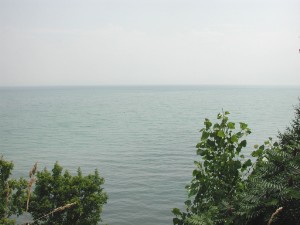 Image via Wikipedia
Image via WikipediaGREAT DISASTERS: Disaster on Lake Erie in 1852 - the sinking of the paddle steamer Atlantic... April 2001 - By Nanna Egidius, Trond Austheim & Børge Solem In the middle of June 1852 a group of emigrants departed from Christiania bound for Quebec on the bark Argo, mastered by Capt. Olsen. The transatlantic crossing in those days could be quite unpleasant, and quite hazardous. We can only imagine what relief the passengers on the Argo must have felt as they reached Quebec on August 12th. However, the immigrants now faced another long journey, which went by railroad and wagon, for some also partly by foot, but first and foremost by ship on the Great Lakes. The inland voyage was also combined with a considerable danger to the venerable newcomers. Captain Olsen on the Argo contracted with a company to carry the emigrants and their baggage to Milwaukee for seven dollars for each adult and half fare for the children. On August 14th the baggage was brought aboard a large steamboat and in the evening at five o'clock they departed from Quebec. At six the following morning they came to Montreal. Captain Olsen had accompanied the passengers, and took leave of them there. Shortly after he had gone, an accident occurred. Thorsten Nilsen Majestad from Valdres fell overboard as he was bringing his baggage of the boat. It was right pitiful for the others to see how he struggled. And no means were on hand whatsoever with which to save him. Arrangements were finally made for dragging, whereupon he was found, but by then he was dead. This event was all the more tragic since he had a family, which mourned its lost provider At Montreal their baggage was taken in wagons about one English mile, and then they traveled by steamboat for about twenty-four hours. they passed through many locks which they looked at with wonder. They reached Toronto but could not get a boat to proceed the day they arrived there. Their baggage was unloaded on the wharf, and most of the immigrants spent the night under open sky. At eight the next morning they left by steamboat, and in the afternoon of the same day they landed below the Niagara Falls, near the ingenious hanging bridge made of steel cables. Many of them had decided to go near this masterpiece and inspect it, but they had to forego this, as their baggage was immediately loaded on wagons and drawn by horses on a railway for about sixteen English miles. On this trip they had the opportunity to view the great and much-famed waterfalls, Niagara. They came to the town of Kingston late in the evening. There, too, their belongings were placed on the wharf, and again most of the immigrants found lodging on the wharf. Some of the immigrants left for Buffalo on a small steamboat at five o'clock the next morning. At five in the evening the boat returned and got the rest of them. From Quebec to Buffalo some seventy-five poor people from Valdres had free transportation. But here they had to remain as they did not have enough money to pay passage across the Lakes. At Buffalo a group containing of 132 Norwegian immigrants boarded the steamer Atlantic, mastered by Capt. Patty. At eight o'clock of the evening on August 12th, the Atlantic departed from Buffalo bound for Detroit. The total number of passengers was 576, comprising the 132 Norwegians, a number of Germans, and the rest Americans. About two o'clock in the morning of August 20th the Atlantic collided with the Ogdensburg, and the disaster was a fact.. The description above is mainly based on a letter from Erik Thorstad, Town of Ixonia, Jefferson County, Wisconsin, November 9th 1852, to parents and siblings in Øyer. The white line on the map below shows the route Erik Iversen Thorstad and the other Norwegian immigrants took from Quebec to Milwaukee. The white star marks where SS Atlantic sank in 1852. Below is Erik's own description of the voyage and collision. Read more: |


Post new comment